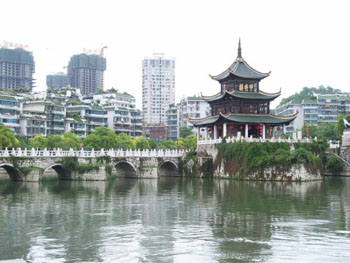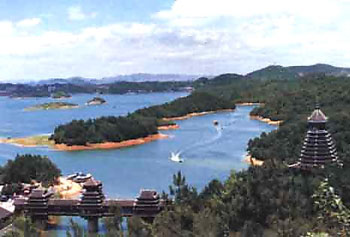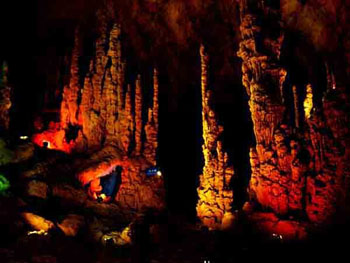search for a Trip
Introduction of Guiyang
 Guiyang is the capital of Guizhou Province. Covering an area of 176,000 square kilometers with beautiful scenery, pleasant climate and abundant tourist resources it is a developing tourist resort of China. Guiyang City has a long history. There are many historic sites built in Ming and Qing Dynasties. Some of them, such as the Hongfu Temple, the Kylin Cave, the Jiaxiu Pavilion and the San Yuan Palace, have gone through several hundred years.
Guiyang is the capital of Guizhou Province. Covering an area of 176,000 square kilometers with beautiful scenery, pleasant climate and abundant tourist resources it is a developing tourist resort of China. Guiyang City has a long history. There are many historic sites built in Ming and Qing Dynasties. Some of them, such as the Hongfu Temple, the Kylin Cave, the Jiaxiu Pavilion and the San Yuan Palace, have gone through several hundred years.
Main attractions in Guiyang
Huangguoshu Falls
The Huangguoshu Scenic Spot is located to the southwest of Guiyang. Being one of the first national key scenic spots issued by the state, it is composed of more than ten ground and underground waterfalls, the enchanting Tianxing Park and the Aquatic Stone Forest. The Huangguoshu Waterfall is the center of this scenic spot. It is the biggest one in Asia, which are 68 meters high and 84 meters wide. In flood season, it looks like the Milky Way pouring down; making the precipitous cliffs trembling, while mist of water droplets rising from the plunge pool. It is particularly superb when rainbows arch from the plunge pool of the waterfall under the shining sun.
In dry season, water would be separated into several streams falling down from the overhanging cliffs like a fairy maiden's elegant hair, charming and graceful. On top of the precipice opposite the waterfall stands the Pavilion for Enjoying the Waterfall. There is a 134 meters long water- curtain cave behind the waterfall down to the foot. Being in it, one can see the plunging water like numberless strings of pearls flying down over one's head and also the rainbows in the fine drizzle. It is really a spectacular view.

Dragon Palace Scenic Area:
Dragon Palace Scenic Area, located 27 kilometers (17 miles) southwest of Anshun City and over 30 kilometers (18.6 miles) from Huangguoshu waterfall, , is the second most famous attraction in Guiyang. It is a wonderland of limestone caves, underground waterways and waterfalls. Unlike other mountain caves in China, the Dragon Palace is actually a group of five successive water-eroded caverns connected by an over 3,000-meter-long (about 1.9 miles) underground stream, nearly 1,000 meters (3,280 feet) of which has been opened to the public. Tourists can take a boat trip through each cave and appreciate the various stalactites, rock formations and stone pillars as if they were taking a trip to the legendary crystal palace where the Dragon King lived in the sea. The narrowest part of the cave is only two meters (6.6 feet) in width and the highest point can reach over 80 meters (262 feet).

Zhijin Cave
The Zhijin Cave Scenic Spot lies in Zhijin county. Covering an area of 450 square kilometers, it is one of the scenic spots of state rank. The whole scenic spot consists of four parts - the ancient town of Zhijin, the Zhijin Cave, the Jie River Gorge and the Hongjia Ferry. As the cream of this scenic spot, the Zhijin Cave is the biggest treasury of cave resource, both in scale and peculiar shape, discovered in China at the moment. The cave extends about 10 kilometers. The broadest part of the cave is of 173 meters and the highest reaches 150 meters. There are more than 40 kinds of Karst precipitation forms in the cave including the main kinds of those in the karts caves all over the world and known as the "Karst Museum". Out of it are villages of the Buyi, Miao and Yi nationalities.
Jiaxiu Tower
 Built in 1598 during the Ming Dynasty, Jiaxiu Tower is located on the Aoji Rock (the rock which looks like a huge turtle according to legend) on the Nanming River in the southern part of Guiyang City. It is renowned for its layout such as the three-story tower 20 meters high with three carved eaves supported by a stone pillar and atop which is formed by diminishing size as four directions mount up. Located in water, right of the Guanyin temple and the Cuiwei tower; left of the Haibi pavilion, the Jiaxiu Tower is connected with two banks by the Fuyu Bridge (Floating Jade Bridge). All of these make Jiaxiu Tower spectacular.
Built in 1598 during the Ming Dynasty, Jiaxiu Tower is located on the Aoji Rock (the rock which looks like a huge turtle according to legend) on the Nanming River in the southern part of Guiyang City. It is renowned for its layout such as the three-story tower 20 meters high with three carved eaves supported by a stone pillar and atop which is formed by diminishing size as four directions mount up. Located in water, right of the Guanyin temple and the Cuiwei tower; left of the Haibi pavilion, the Jiaxiu Tower is connected with two banks by the Fuyu Bridge (Floating Jade Bridge). All of these make Jiaxiu Tower spectacular.
Many antithetical couplets were carved or written on the Jiaxiu Tower by ancient people. Among them, the most famous couplet written by Liu Yushang in the Qing Dynasty has 87 words in the first line and the second line respectively can compare in beauty with the Big Guan Tower in Kunming. Jiaxiu Tower is a famous wooden tower in Guiyang and is regarded as the symbol of the city.
Red Maple Lake
As a national scenic resort, Red Maple Lake is located in the suburb of Qingzhen, 33 kilometers from Guiyang. Covering 57.2 square kilometers, it is the largest man-made lake on the Guizhou Plateau. The lake consists of the North and South lakes. It's renowned for the 170 isles, the numerous caves, the clear water and the quiet bays. Folklore of the Dong and Miao people is demonstrated in the resort.
Qianling Park / Hong Fu Si Temple
This large city park is well worth an afternoon. Sample local food and crafts from vendors, see wild monkeys (accustomed to people), see the view from the hilltop near the temple. The temple, built as a monastery in the early Qing dynasty, is comparable in extent to the Lama Temple in Beijing. Surrounded by woods, the buildings have elaborate ornaments (roof corners and eaves, etc). There are several large deity figures, a pond with carp, water well for coins for good luck, incense burning pits, a large bell you ring, some shops, and a restaurant there. It is 40-60 minute walk to the temple, but there is also a cable car (stops at 17:00), and sedan chair rides.
Climate in Guiyang
Guiyang has a humid, sub-tropical monsoonal climate with warm winters, mild summers and unclear seasonal contrasts. It has a mean annual temperature of 14°-16oC, and a mean annual precipitation of 1,100-1,400 mm. It has more overcast days than any other part of the country, the area around Guiyang averaging 220 cloudy days a year.
|
Month |
Jan |
Feb |
Mar |
Apr |
May |
Jun |
Jul |
Aug |
Sep |
Oct |
Nov |
Dec |
|
Temperature (Celsius) |
5.6 |
6.0 |
15.5 |
16.5 |
19.8 |
22.8 |
28.0 |
30.4 |
27.4 |
20.0 |
15.7 |
11.3 |
Click to see Guiyang tours
China Attractions Guide
- Anhui Attractions
- Beijing Attractions
- Chongqing Attractions
- Fujian Attractions
- Gansu Attractions
- Guangdong Attractions
- Guangxi Attractions
- Guizhou Attractions
- Hainan Attractions
- Henan Attractions
- Hongkong Attractions
- Hubei Attractions
- Hunan Attractions
- Inner Mongolia Attractions
- Jiangsu Attractions
- Jiangxi Attractions
- Manchuria Attractions
- Ningxia Attractions
- Qinghai Attractions
- Shaanxi Attractions


